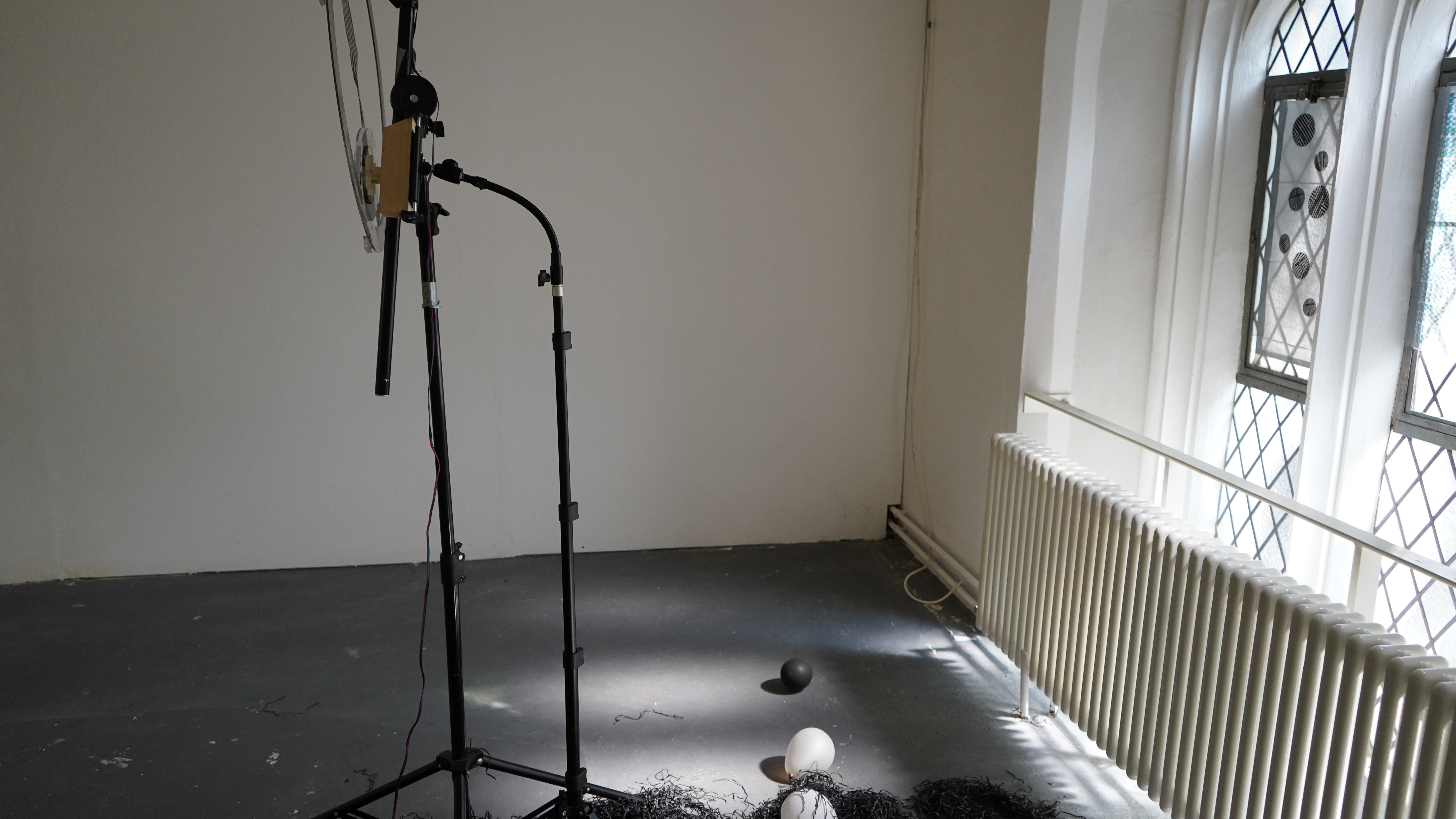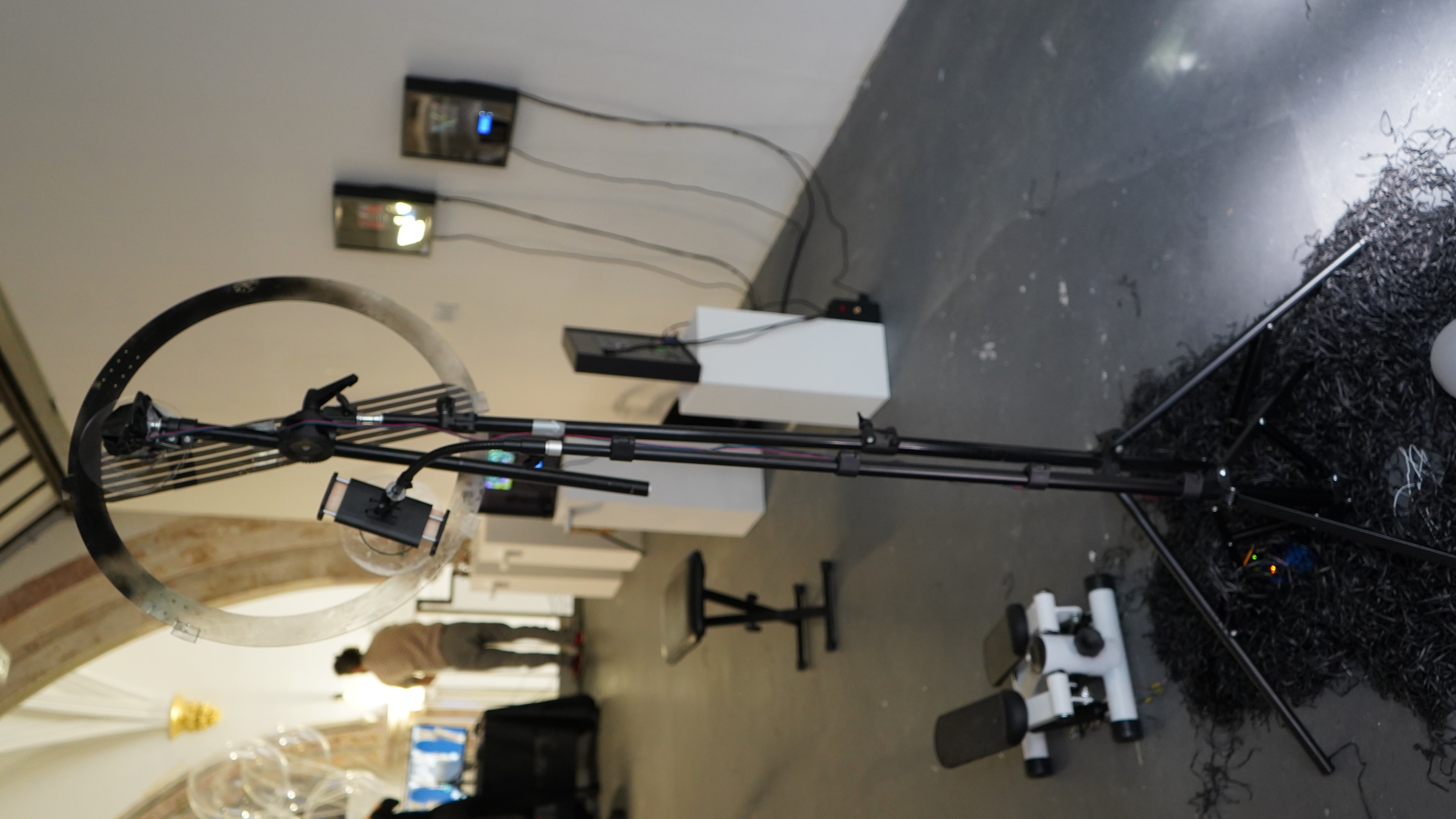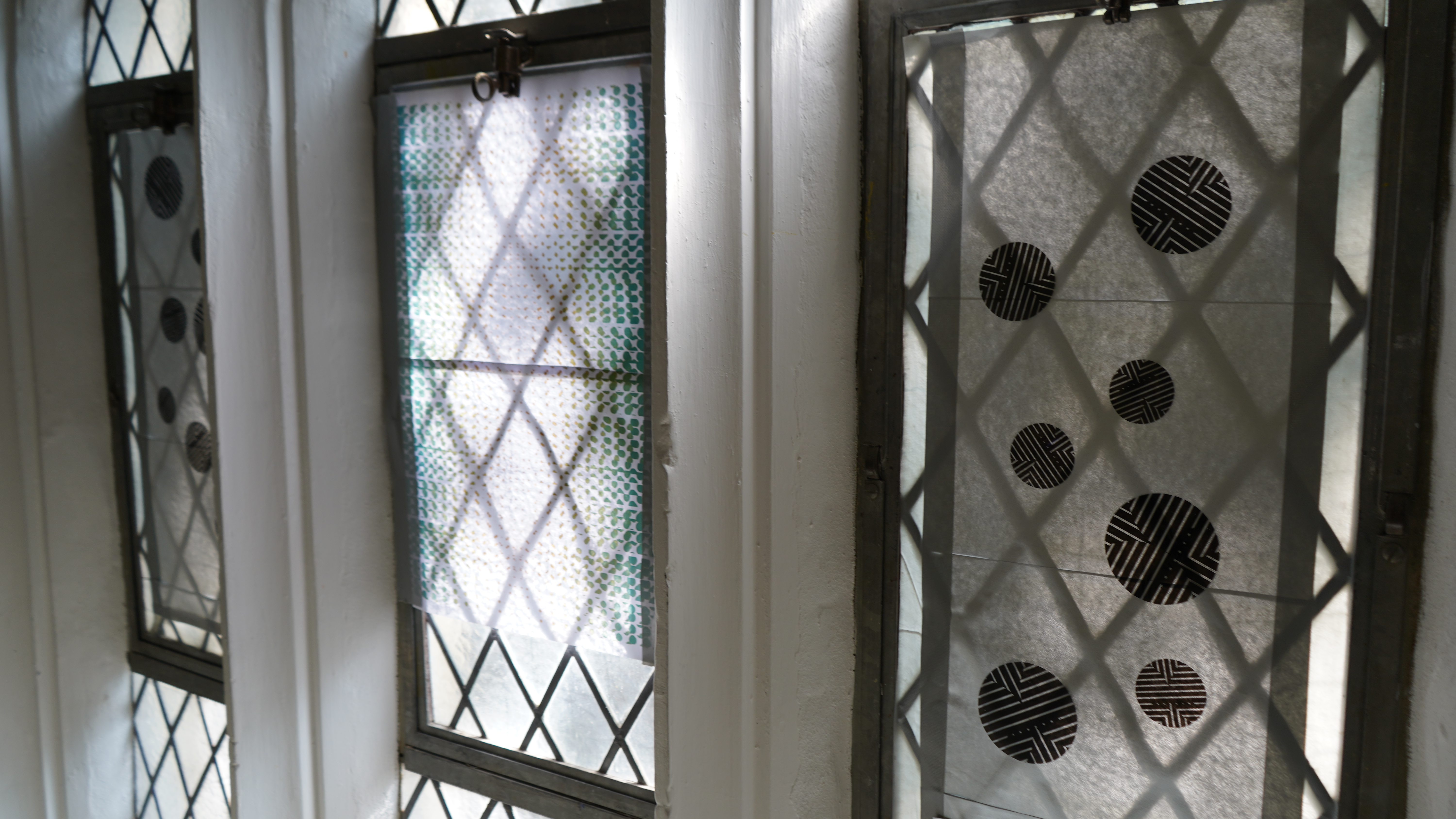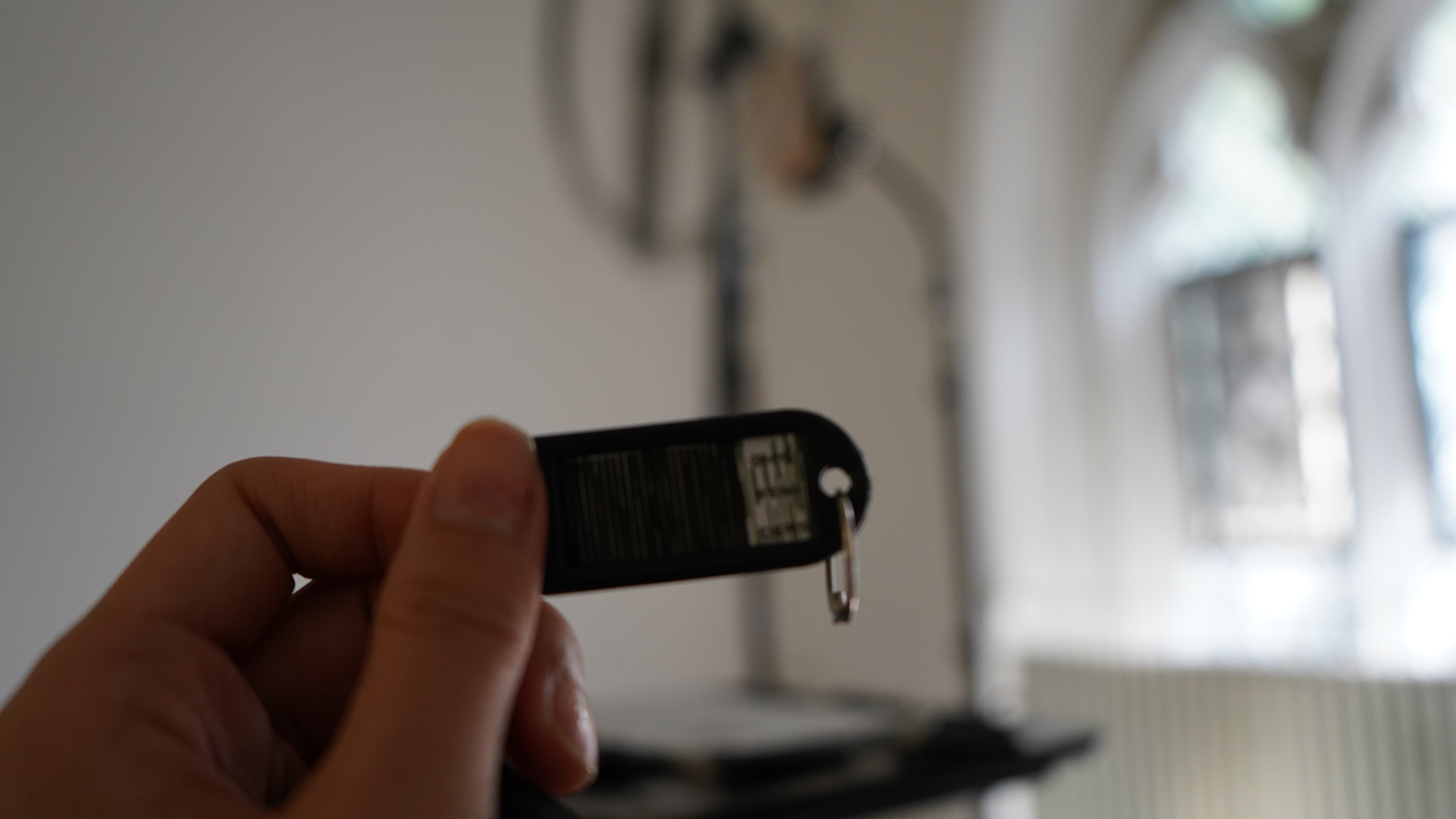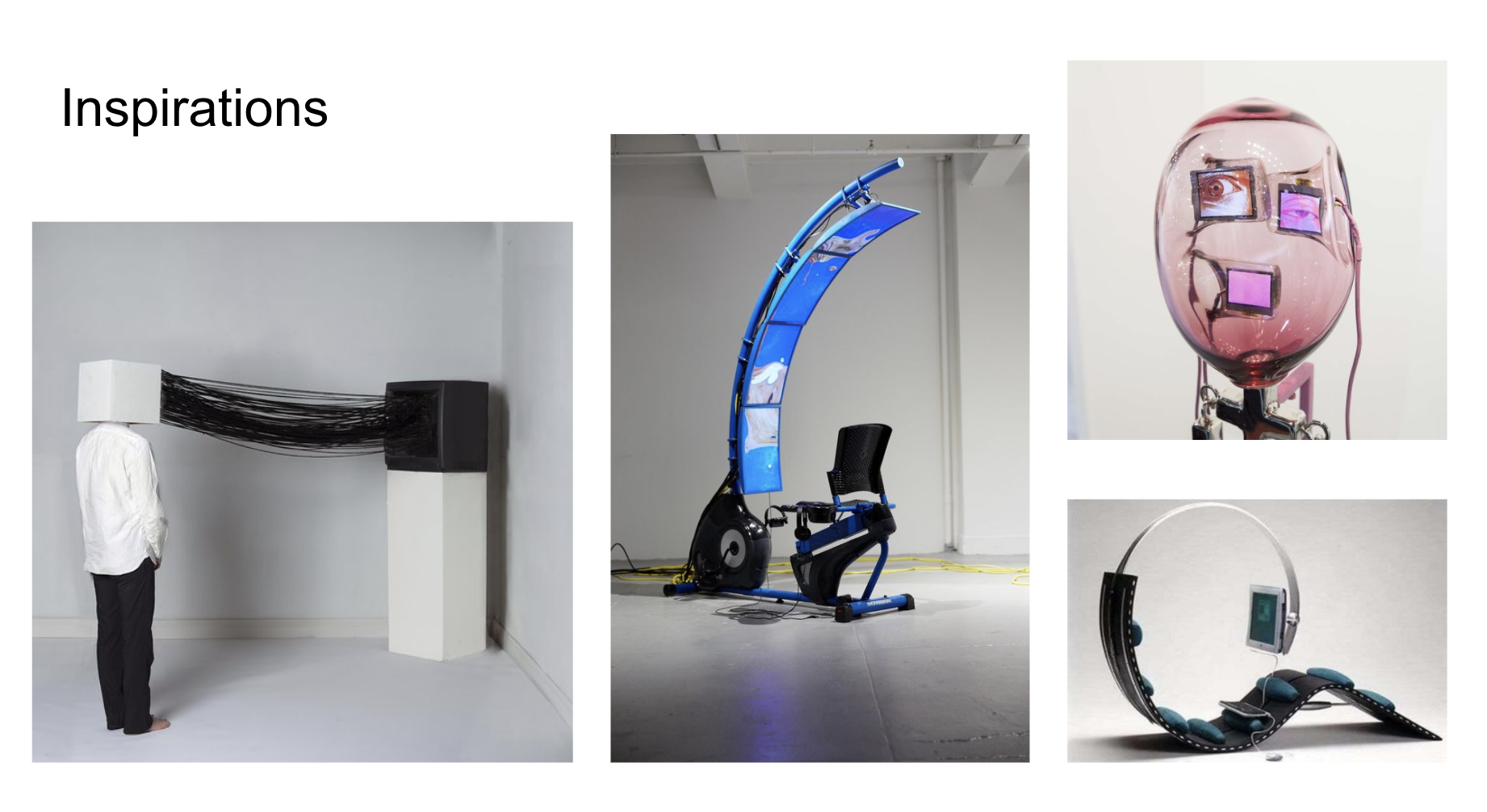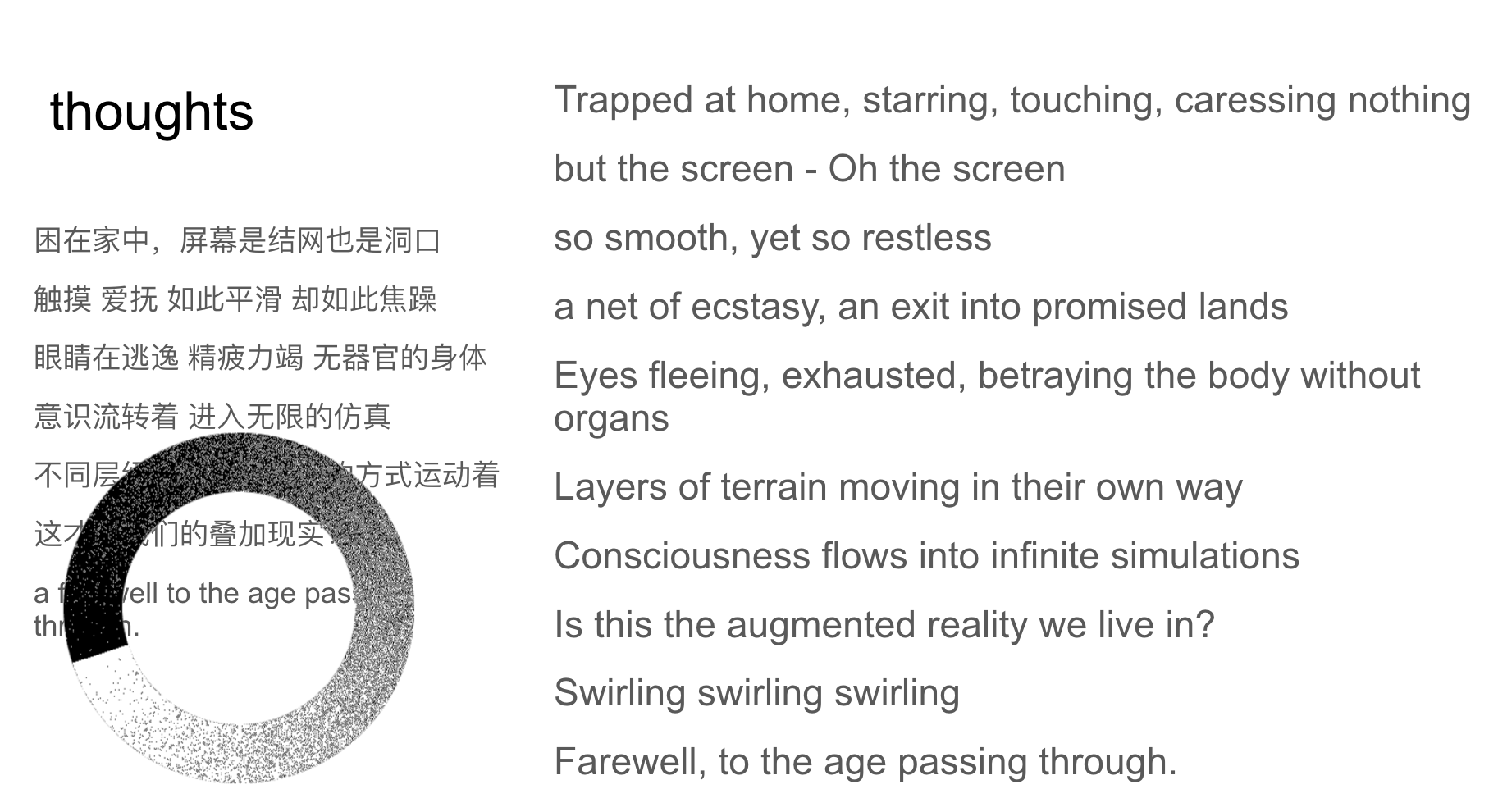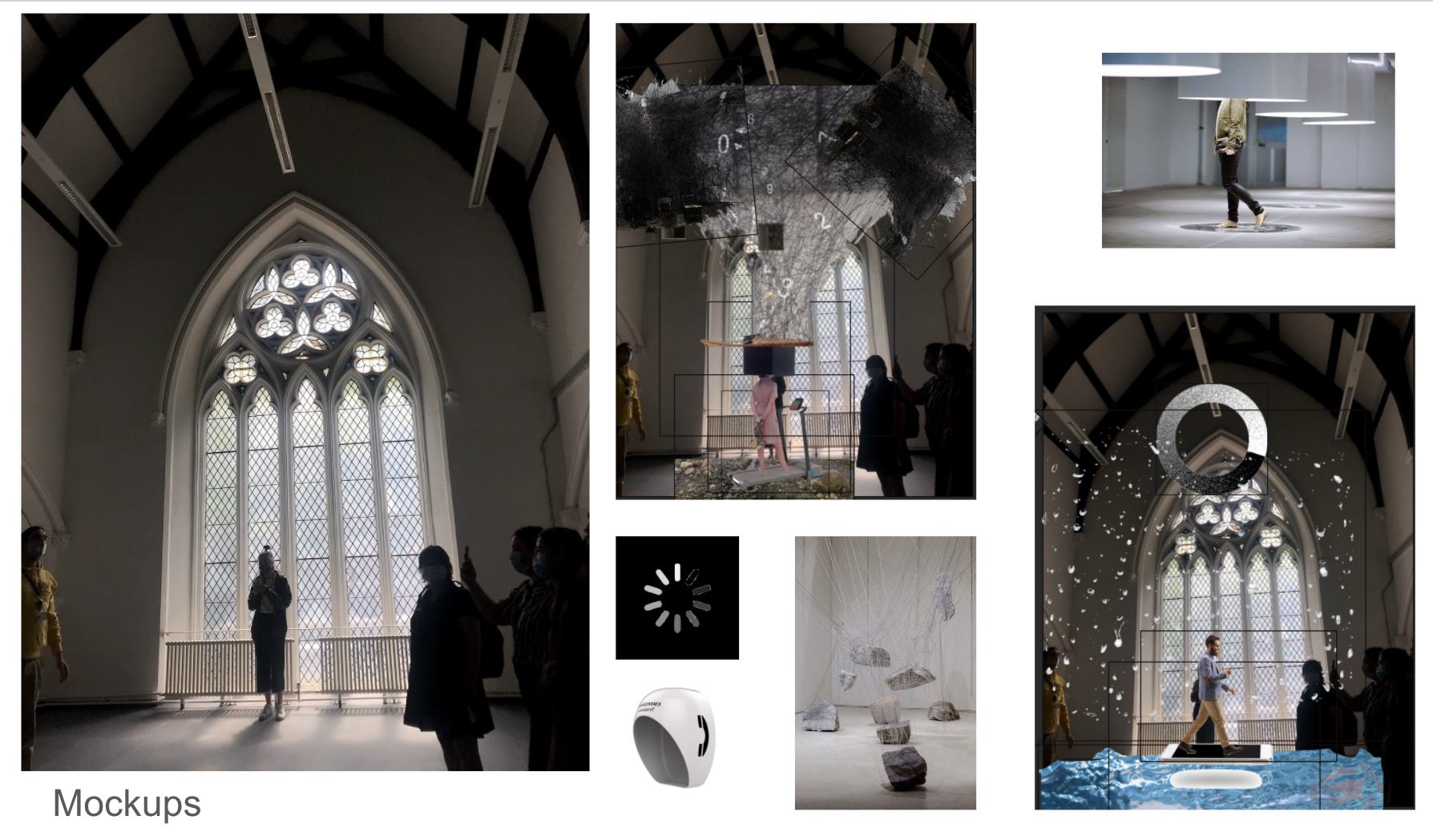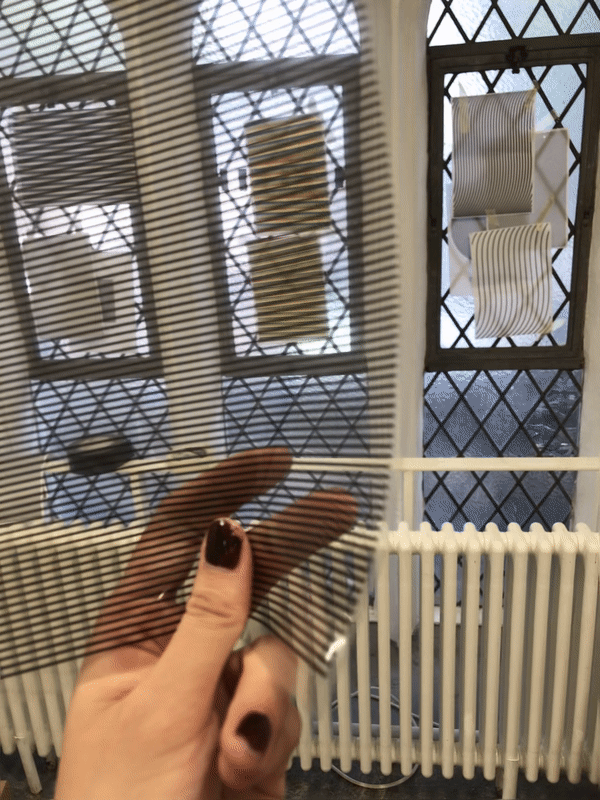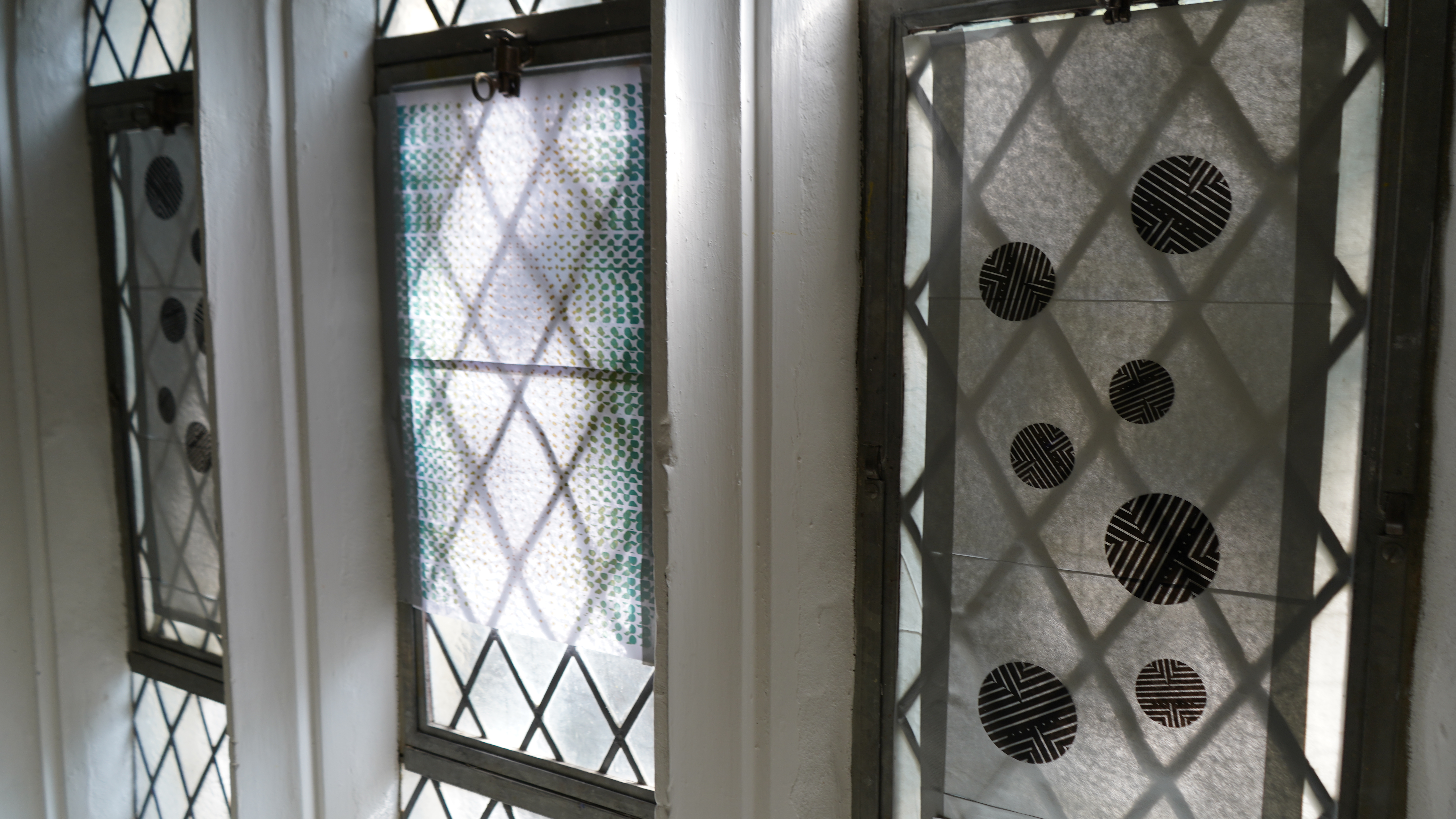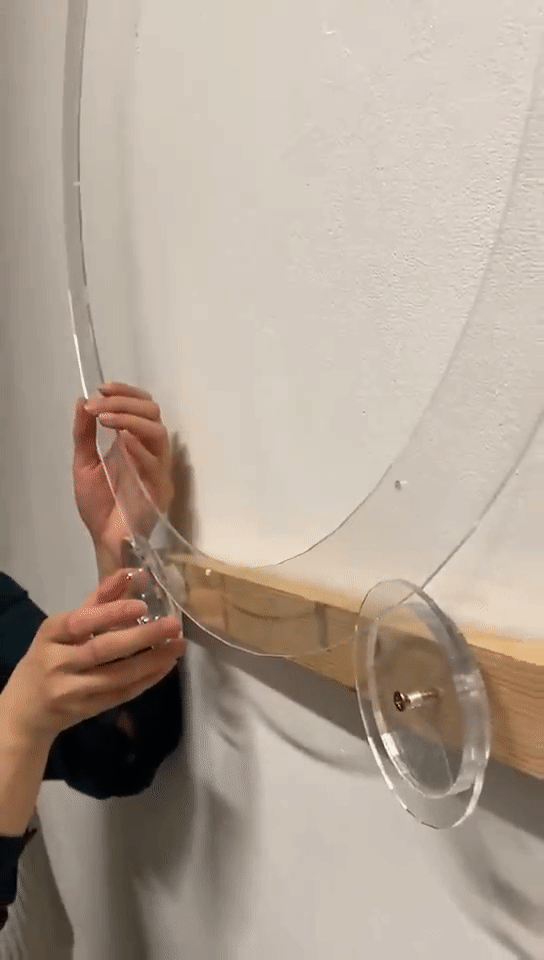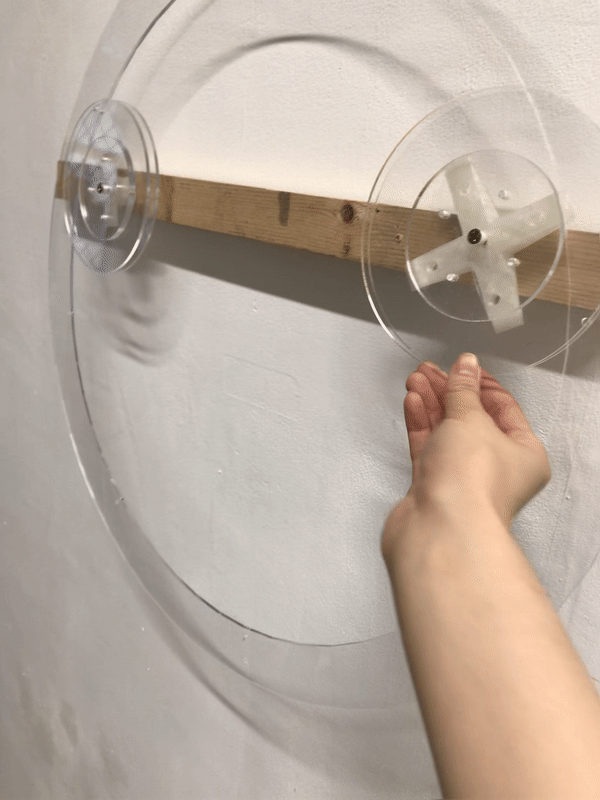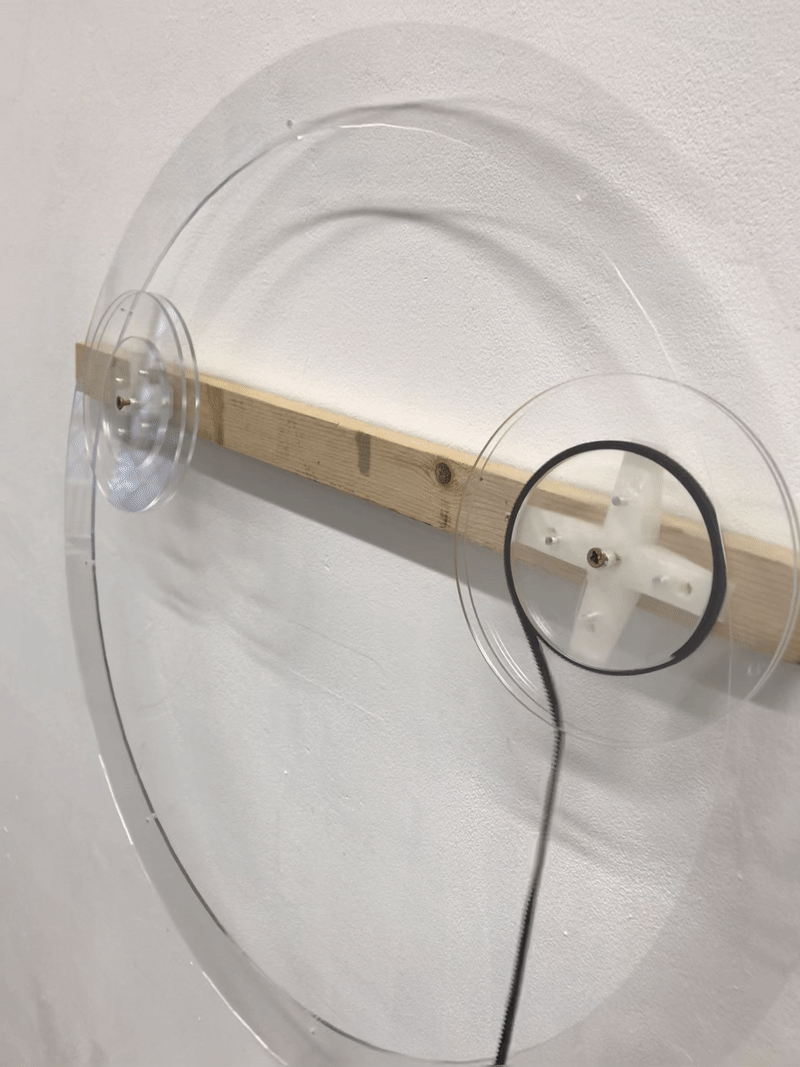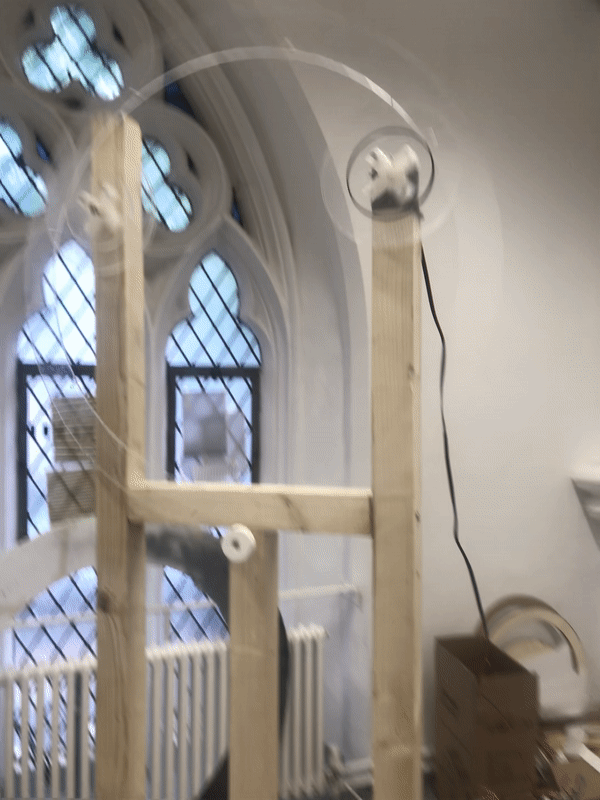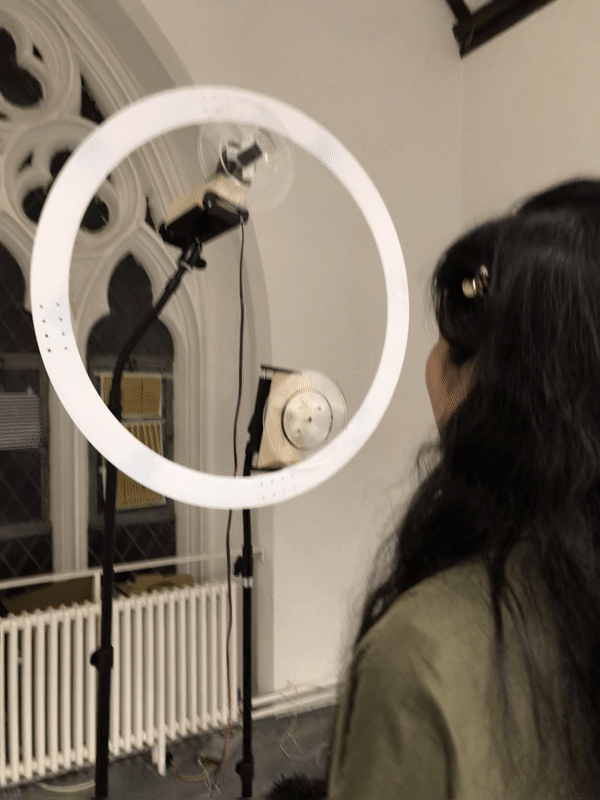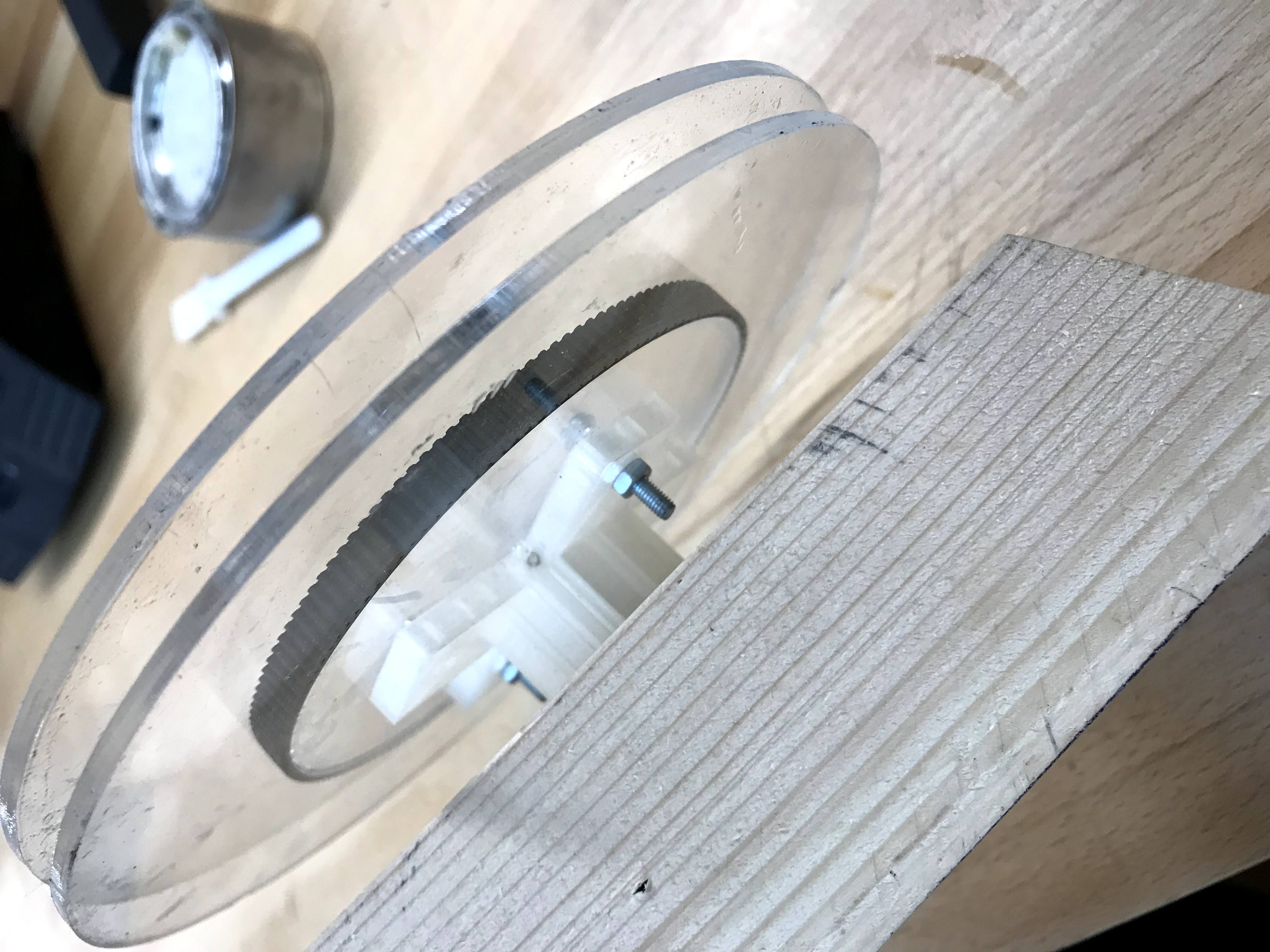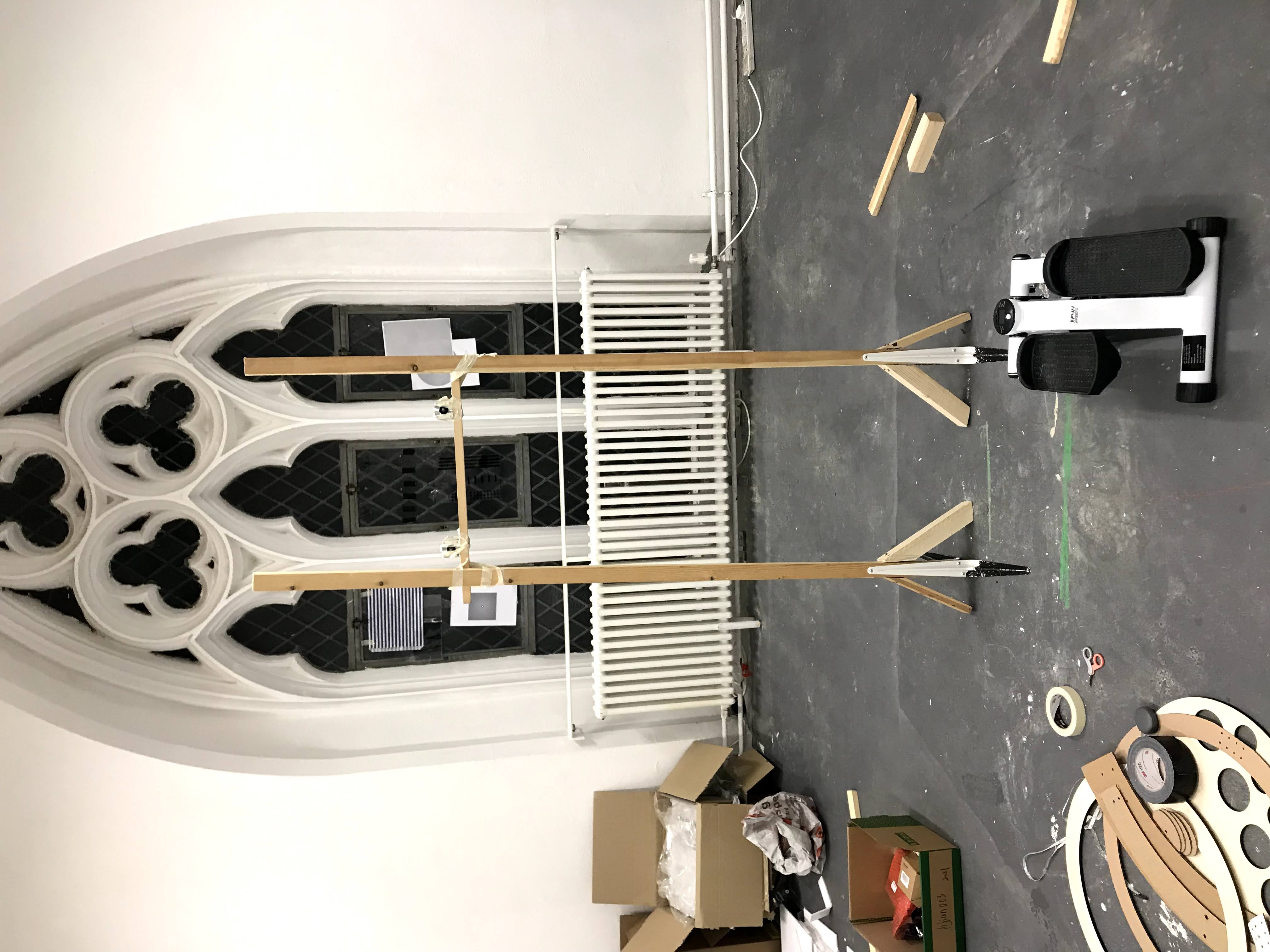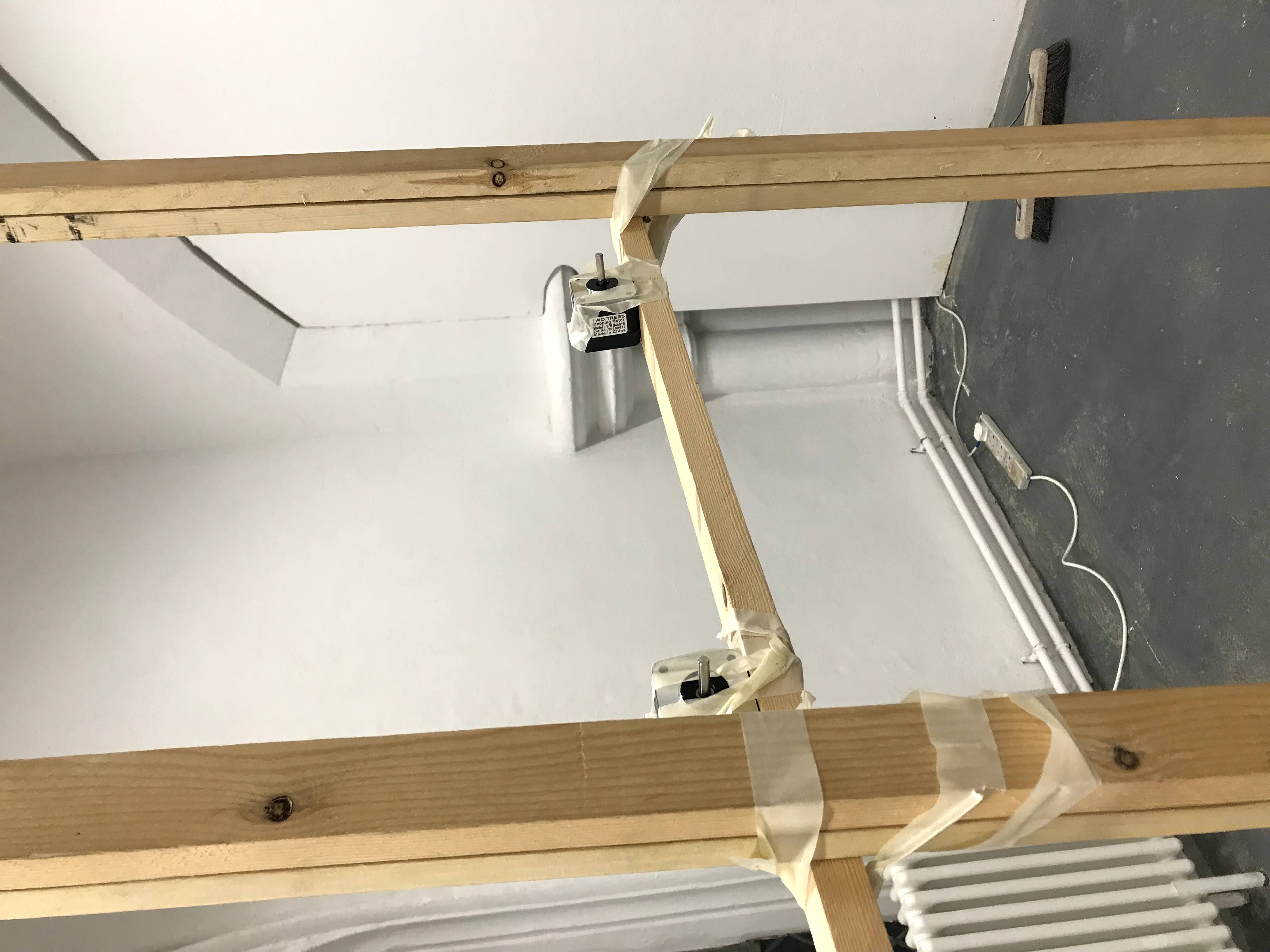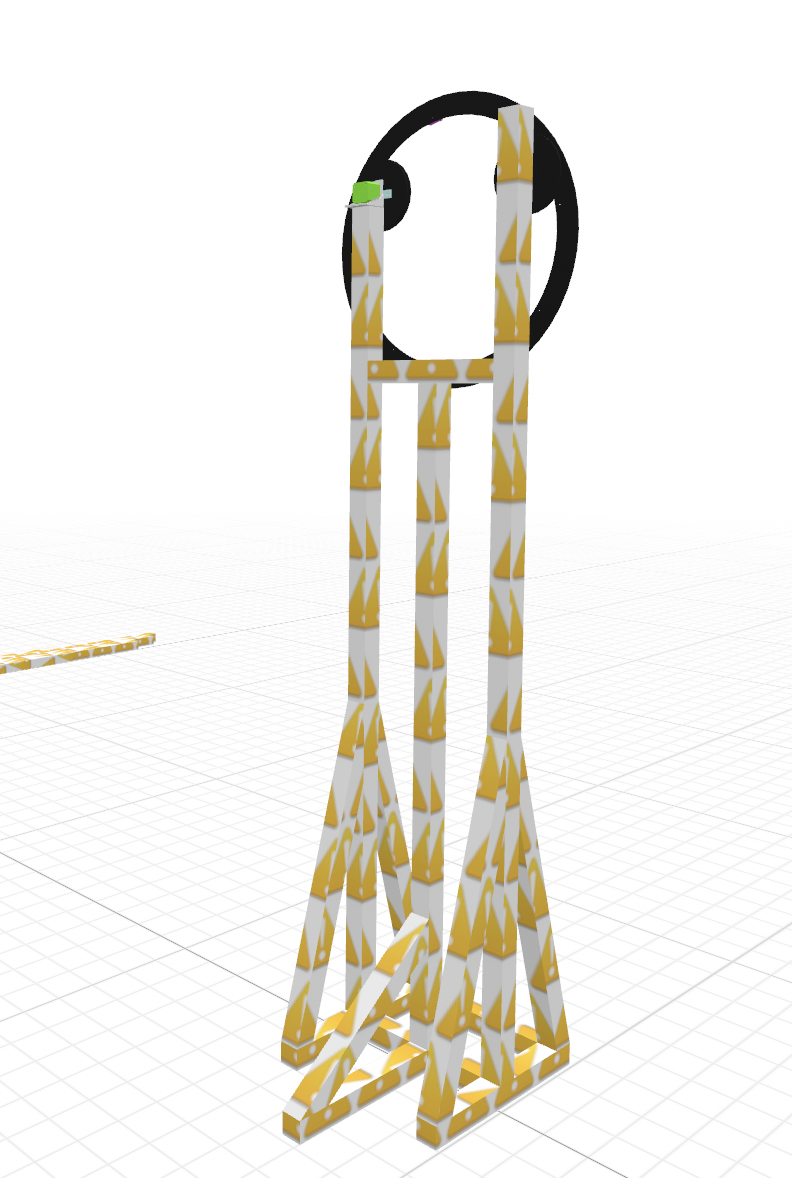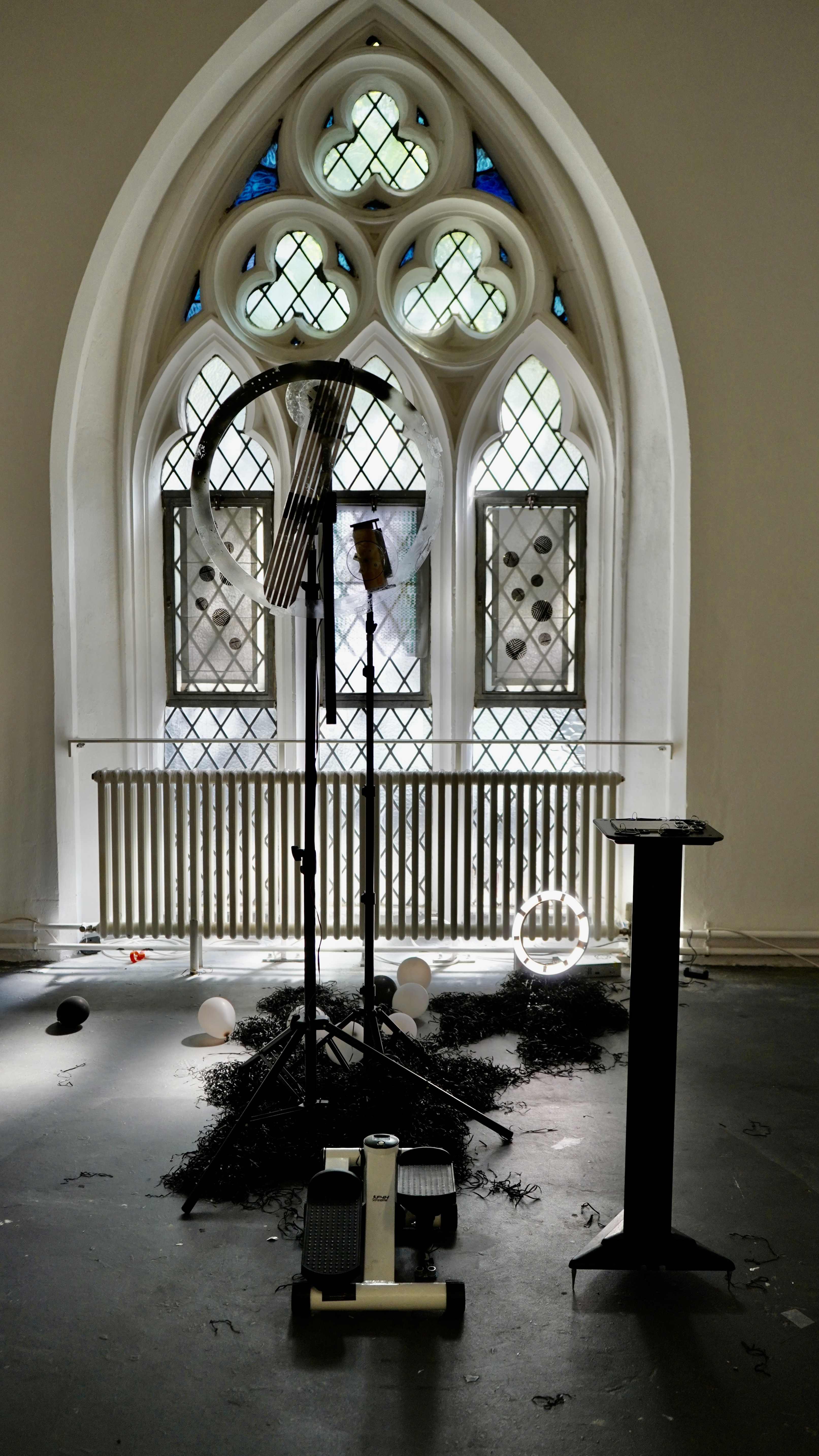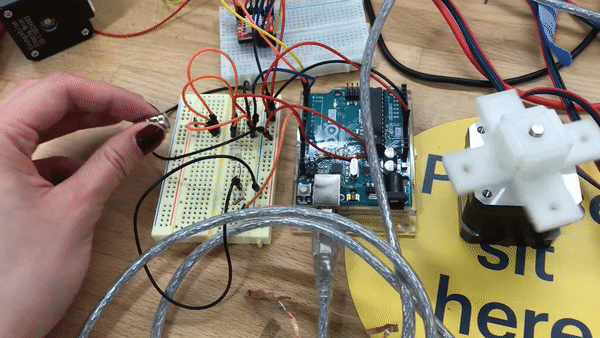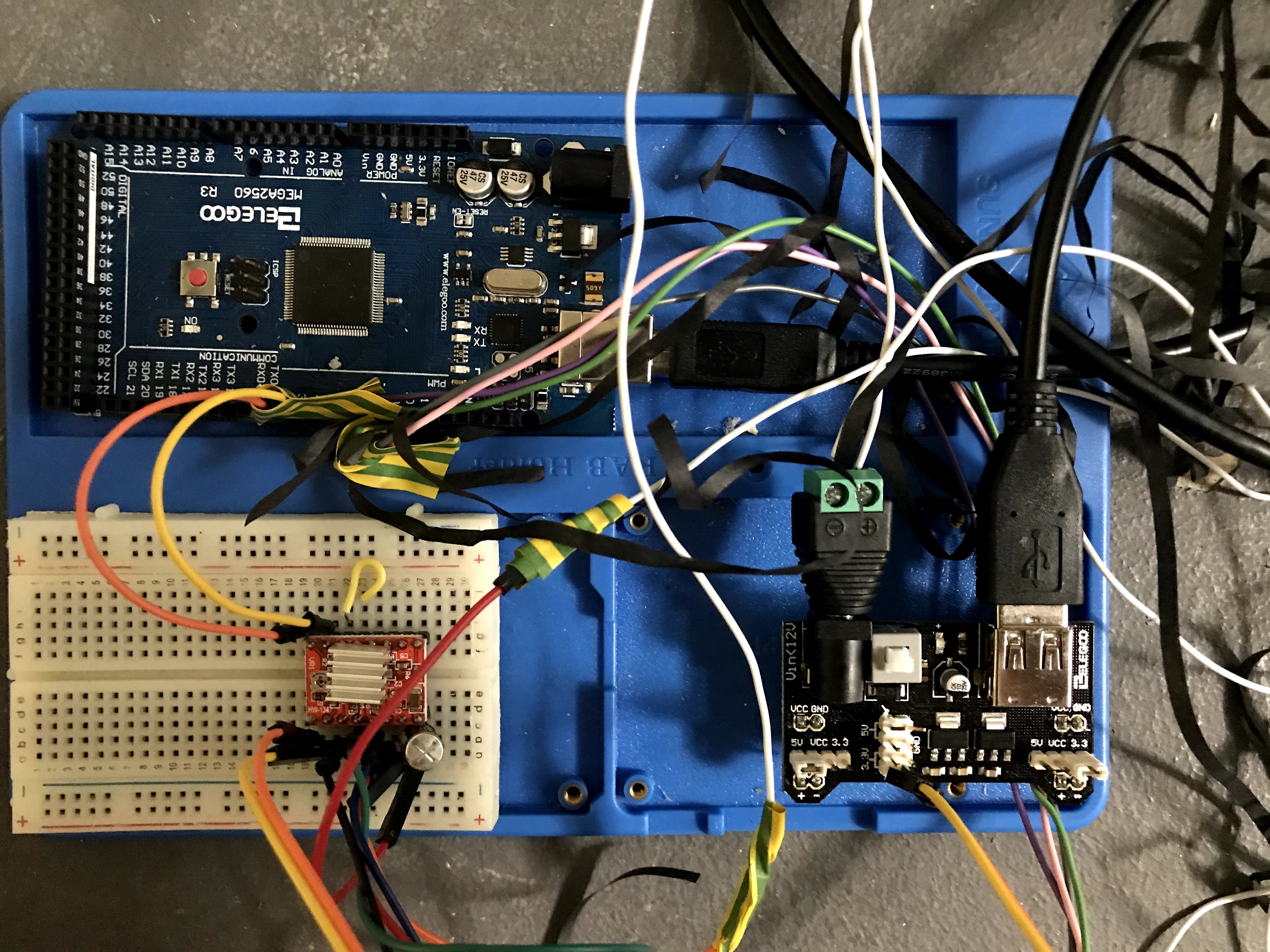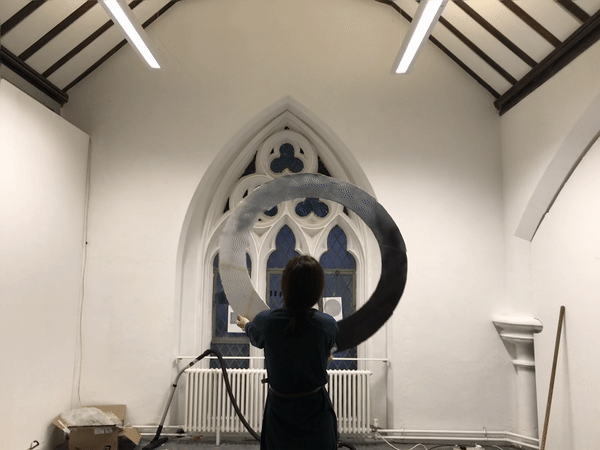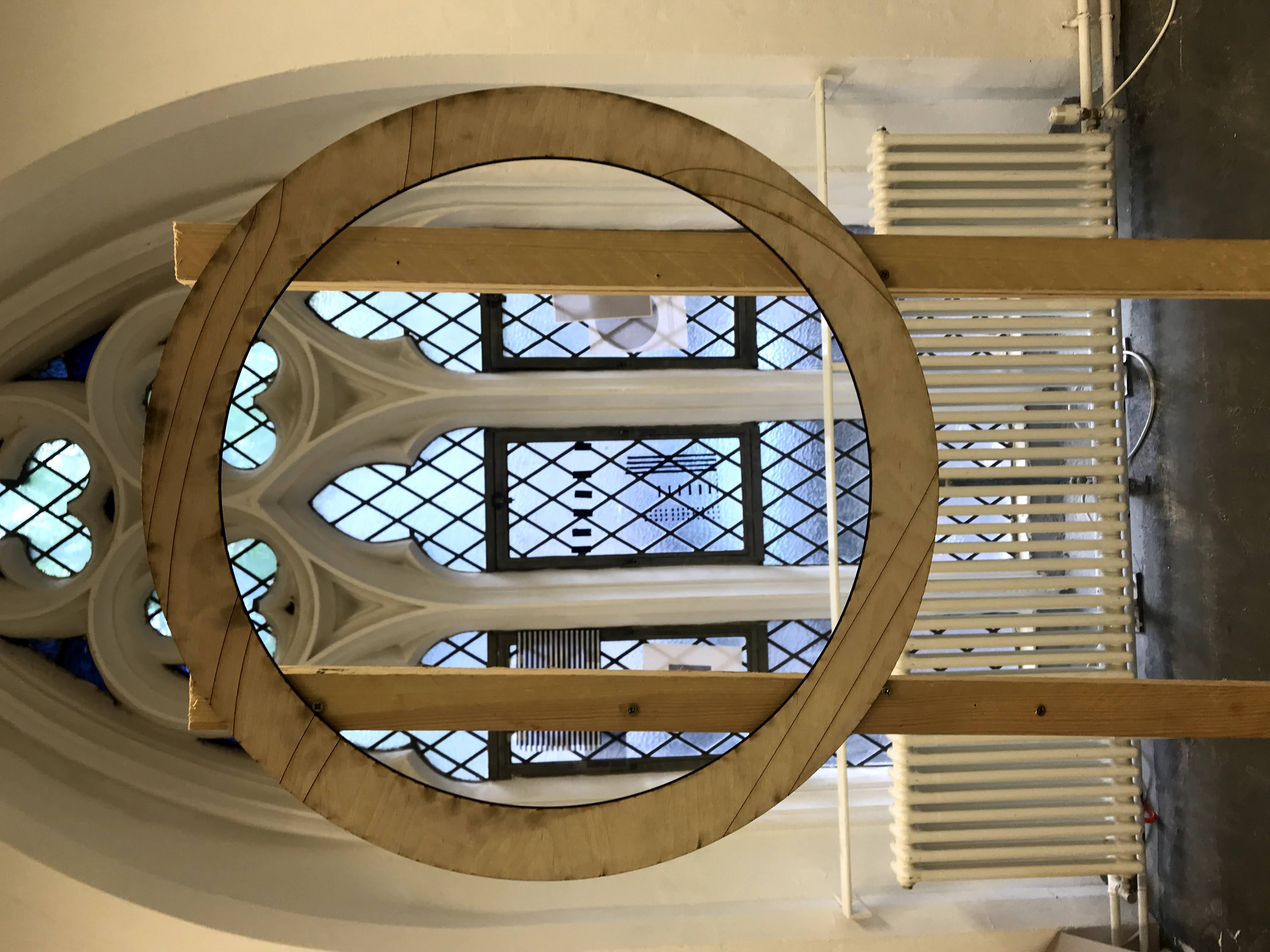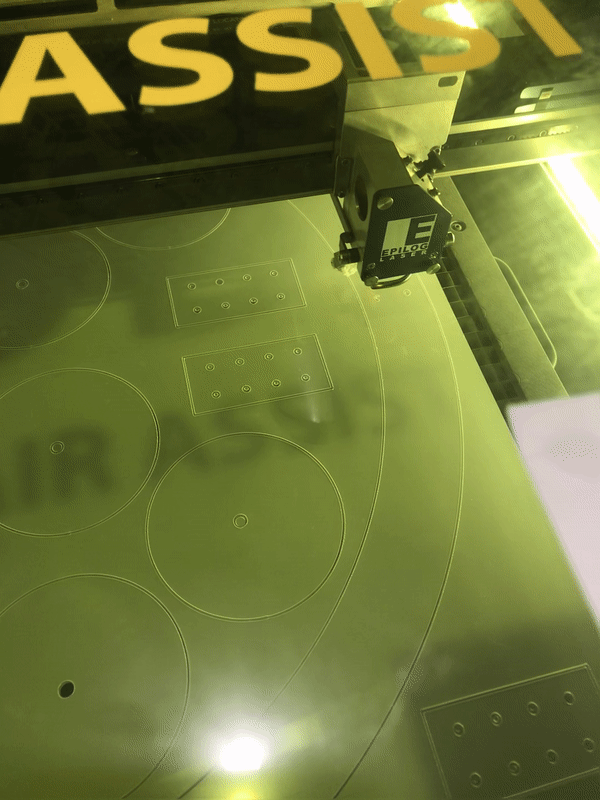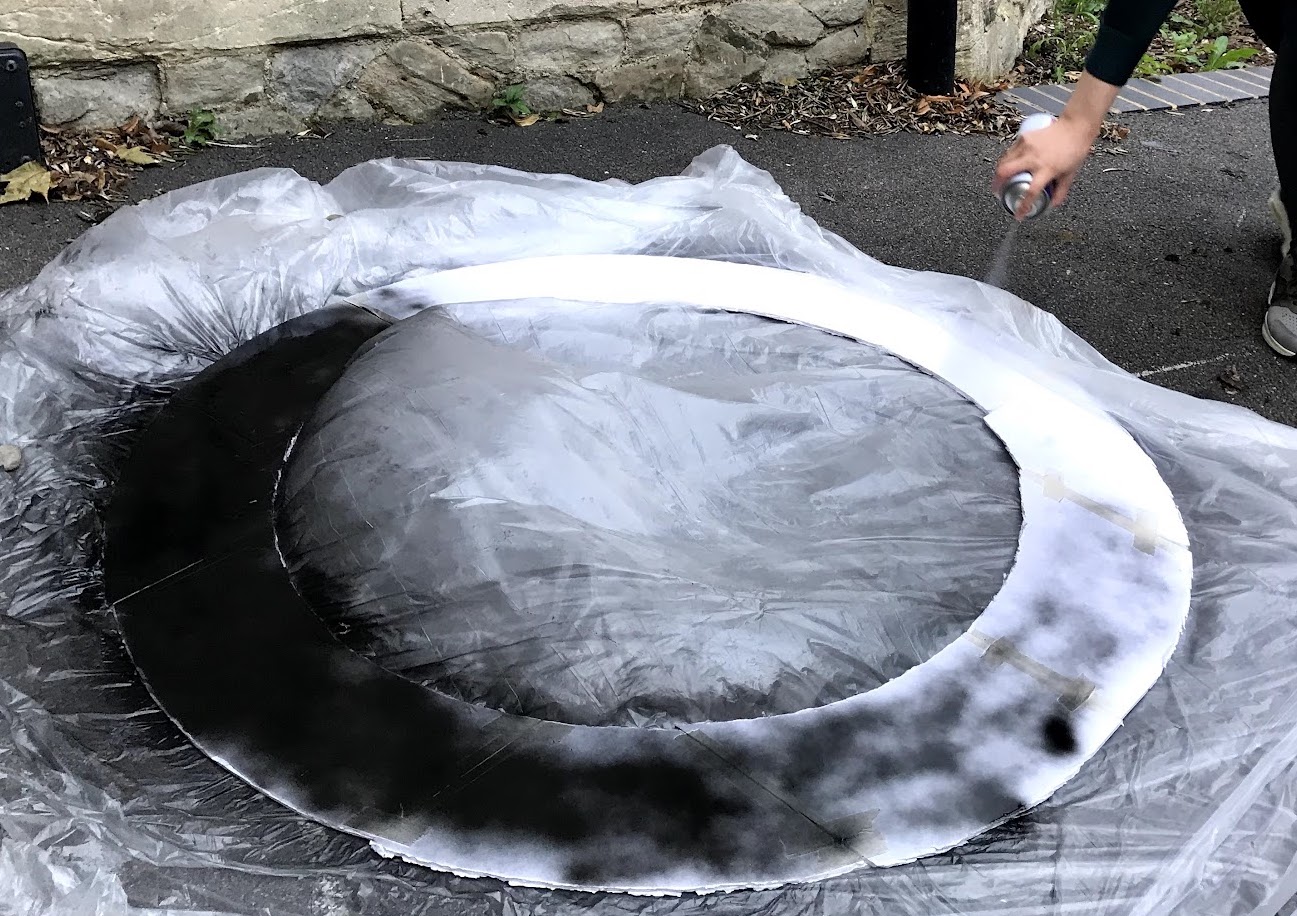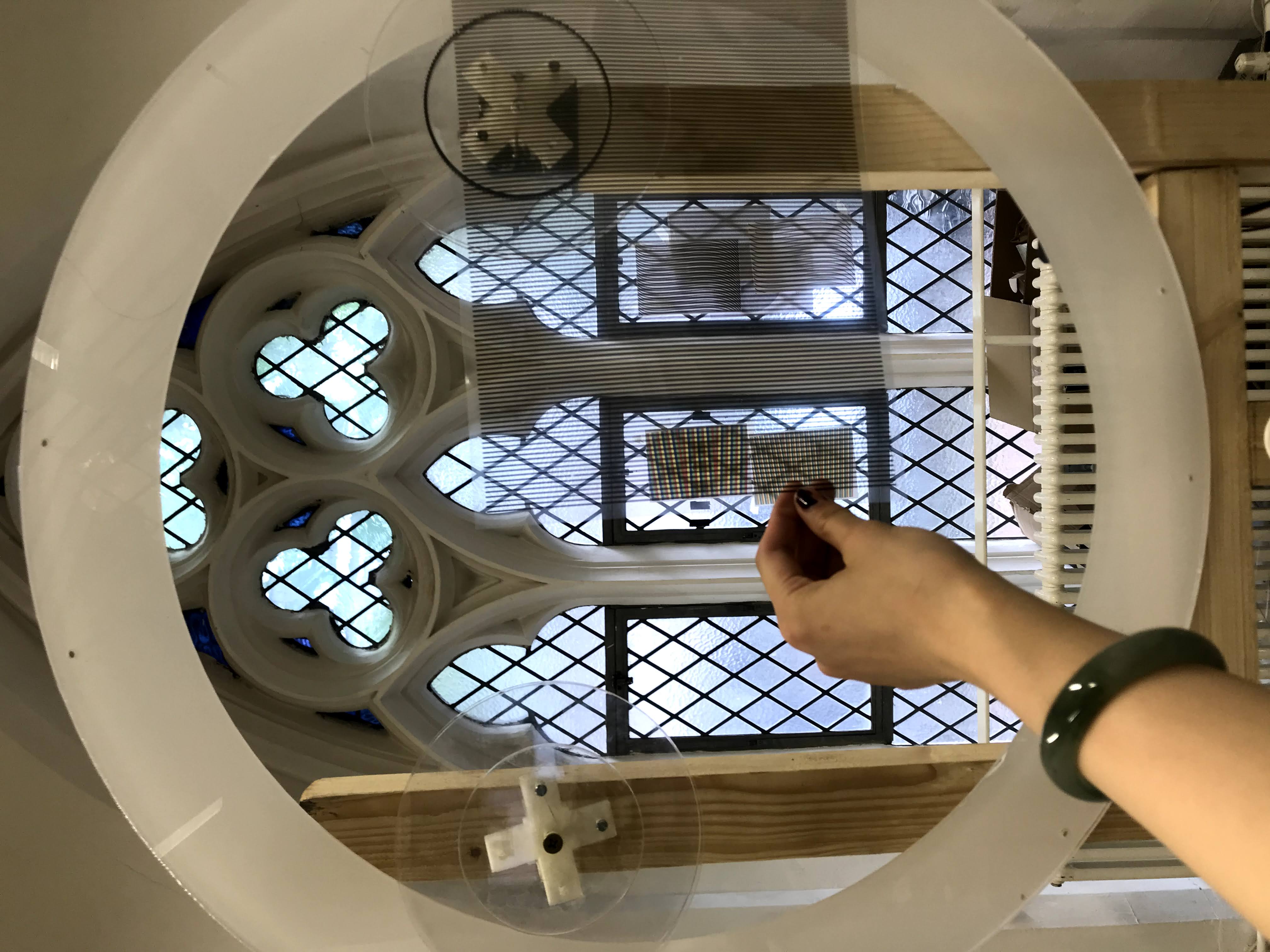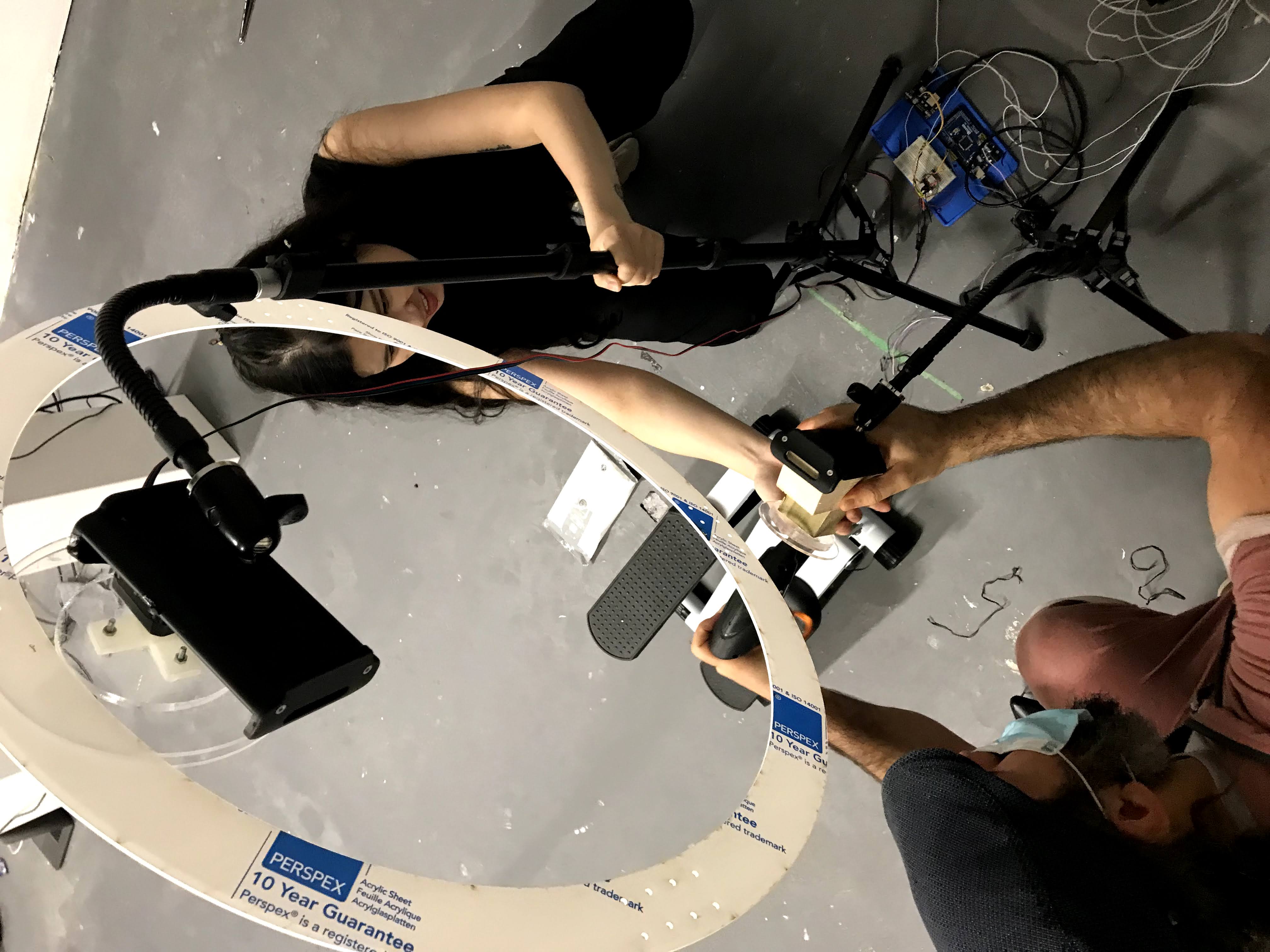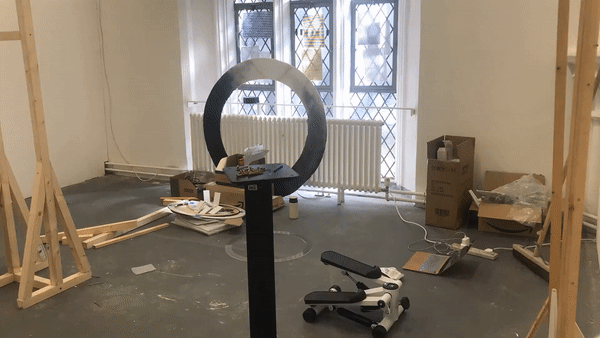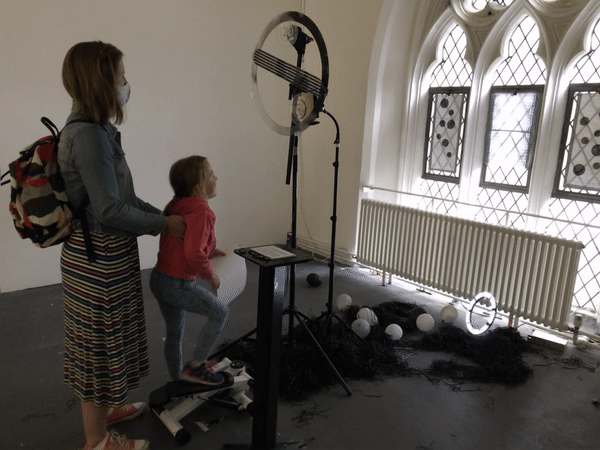Arthritis
This installation explores one's relationship to the screen. By mapping one's working steps to the rotation of the step motor, which leads to the generation of dynamic moire patterns, this project attempts to create a "screenless" screen experience using analog materials, and thus examines the relationship between digital media and physical/emotional labour in the everyday life.
produced by: HumYeh
Introduction
Arthritis is a site-specific interactive installation consisting of an exercise stepper, a buffering sign wheel, and three patterned windows of the church. As the participant steps on the pedals, the buffering wheel will be actuated and rotate accordingly, generating and revealing moiré pattern onto the windows through the meshes, finally the patterns will be simulated and synchronised through online. By centring what's often regarded as disturbance, noise, or frictions in digital screen culture through analogue materials under the church arch, this work attempts to reflect on our irreversible relationship to new media in a rapid changing digital environment post-pandemic.
(press > or < to browse photo gallery)
Context
The project originated from my recent thinking on our experience with the digital screens during quarantine. As we are increasingly immersed ourselves with laptop and mobile phones, we become more and more exhausted albeit not physically moving anywhere - the burnout culture has been present today more than ever brought by the lockdown.
In the Writing Screen, Bernard Stiegler writes, "Today, in this epoch in which we don’t just live among screens but through them, this is what occurs via these interactive writing screens that capture our retentions and protentions by performatively outstripping and overtaking them in light-time, and through the constitution of an absolutely entropic – that is, absolutely unreasonable – automatic understanding."(117) As we're increasingly overloaded yet obsessed with interactive media and sensorial immersion among the 24/7 burnout culture today, what's being produced and consumed involuntarily through the screen, and how are they perceived bodily? Therefore, I decided to make a piece that examines such phenomenon.
Taking inspirations from artists such as Sondra Perry, Takahiro Kurashima, and Bobby Becker, I came up with the idea of having an exercise machine that could empower and drive a display device, while having the actor/audience being stuck in a rotating loading sign.
(press > or < to browse photo gallery)
Concept & Background Research
There were some crucial concepts that lead through the ideation process, namely the infrastructure behind the loading sign, the rediscover of moire patterns, and the conceptual approach regarding the screen.
My original idea centred around the loading sign, which was much illuminated by Neta Alexander's journal Rage against the Machine: Buffering, Noise, and Perpetual Anxiety in the Age of Connected Viewing, in which she reveals the perpetual anxiety invoked and exposed by buffering and other digital delays. Identifying buffering as a pharmakon - a Greek philosophical term meaning "remedy, poison, and scapegoat", she writes, "By venting their temporary rage on their gadgets or machines – only to quickly resume their actions and forget they ever encountered a disturbance – internet users are able to sustain the illusion that they understand and control the technology, the codes, and the invisible systems that shape their daily lives." (3). In addition, Alexander noticed the urge to deny contingency among convergence and immersion culture whose logic and infrastructure are mostly invisible and unfathonable to its users, "we acknowledge and forget, become upset and frustrated, but still hope that the streamed content will continue and our dreams will once again become rewired."(7) Her writing has since lead me to ponder, does the omnipresent loading sign appear to us only as a passing daydream, a trance, a merely digital phantom, or something more substantial and inevitable?
Alexander's passage about disruption is somewhat reminiscent of Maryann Donne's analysis in Information, Crisis, Catastrophe on television and catastrophe, "Catastrophe, conjoining death with the failure of technology, presents us with a scenario of limits—the limits of technology, the limits of signification."(321). In addition Having witnessed multiple crises since the pandemic culturally, socially and environmentally, I came to realise the pressing need to reflect and investigate the condition we live in and technology surrounded by through this work.
The reason I chose to implement the element of moiré pattern lies both in its form and context. The "moiré pattern", originated from the French, translated as "water ripple", is episodic, ephemeral and variable yet a highly neglected phenomenon of life that contains an infinite variety of beauty and complex scientific principles. Often appearing in cell phones, cameras, photograph electronic screens (TV, computers, LED displays, etc.) or very dense objects, such as striped screens, textiles, etc., the images always seem unclear, with a circle of ripples attached to them, often showing circular, star-shaped or striped - this is because the interaction between the two basic layers creates a dense and sparse distribution of patterns, resulting in the formation of a third new pattern of dark and light bands. Moiré gradually became more well-known when Optical Art was on the rise and became a unique symbolic language, and thus resulted in changing audience’s habit of viewing arts passively. Moorish surfaces attracts the viewer's eye with its own powerful visual tension, bringing strong visual illusion in depth and breadth, transforming and dissimulating them into different orders, therefore reshaping one’s perception of the structure, size, direction and even sense of dimension of the space.
During the findings I came to realise the distinguishable characters of moiré patterns such as illusional, interactive and generative are inseparable to the screen itself, which also contains a history much longer than normally expected. In The Double Screen: Medium and Representation in Chinese Painting, Wu Hung investigates the threefold connotation of ancient Chinese screen paintings dated back in 13th century, referred to as "huan"/幻, meaning“illusion/illusory”, “illusionism/illusionistic”, and "magical transformation/conjuration". (102) By employing certain media or techniques, such screen device could not only trick the viewer's eye but also his mind, and thus "reverse the relationship between a painted screen and its spectator, who has become extremely vulnerable to the bewildering power of the screen's illusionistic decoration." (118)
The internal division of artistic texts within the screen is illustrated well in Susan Stewart's observation quoted by Wu, "each smaller 'text' is marked by a changing frame, as part of 'a system of differences in relation to any other world. To step into the artistic text is to transform the external into the internal and the internal into the external. And each transformation opens up the possibilities of transformation itself." (127) In summary, it is the the framed spaces that index different systems of reference in a single representation, which solved my initial challenge of the project about designing a "screenless" screen: emphasising on the frame and the illusional viewing space within.
(press > or < to browse photo gallery)
Technical Iteration
The installation of this projects involves mainly three parts: engineering of the rotating wheel through 3D modelling and prototyping, the sensor-motor input/output through arduino, and the moiré pattern generation through processing and illustration.
The engineering part took the longest to figure out, as it has been difficult to balance between the wheel mechanism and safety concerns. My intention was to build a large scale rotating buffering sign with striped meshes inside the wheel so whenever the wheel rotates, the meshes will turn to reveal the patterns, thus the challenges were 1) how to drive a big wheel to rotate vertically high in the air and 2) how to prevent the wheel that is close to the audience for view from breaking/causing safety problems. I had ilterated several versions for the wheel composition attached to the stand and layers between them so to ultilize motor driver for a responsive and safe rotation. Ideally it would be four small wheels, with one driven by stepper motor, and the rest as tractive parts to drive the bigger wheel; I ended up having only one tractive wheel and scaling down the size of the bigg wheel because of safety concerns.
I also experimented with motors for the wheel such as smart car motor set and stepper motors with CNC shield, and found one nema17 stepper motor the easiest to implement while able to drive the wheel to rotate. I had studied different mechanism such as clogs and belted rotation, modelled and tested with several prototypes of the stands. To increase frictions between the small and big wheel added teethed belt so that it will bring more force when rotating.
(press > or < to browse photo gallery)
Material wise I tried different materials for the wheel (paper board, foam board, wood board and acrylic) for the big wheel, and settled on the acrylic as it appears mostly likely to the transparent loading sign and most stable in the air. However, it was challenging to design the stand not blocking the central view of the wheel which the audience would be staring through, as well as a structure that could hold the weight of three layers of acrylic rings from leaning forward. Despite spending a long time modelling and assembling wooden stands, I had to forgo them the last minute because they were difficult to tweak for levelling surfaces on a rugged floor, and replaced them with reassembled tripods in order to adjust by joint parts.
(press > or < to browse photo gallery)
For the stepper-motor part I tried different sensors with the arduino, such as hall sensor, accelerometer and ultrasonic sensors. I settled on ultrasonic sensor because it is most direct for speed detection when positioned under the pedal. To cancel the noise I put shades aside so the pedal movement data would be more accurate. I used arduino to map the pedal speed to the stepper motor's speed (technically the delay time between steps), and set it to run only when the absolute speed of the stepper reaches 2cm/s, so that it won't be activated by small movements.
(press > or < to browse photo gallery)
In terms of design, I had to create both the pattern of the big wheel ("loading sign") and what appears through the windows. Considering different materials I chose to go with the gradient pattern for the buffereing sign wheel as it is more conherent with the rotation movement, and also because it would be easier to recoginize through the scaled down wheel size. For the patterns on the church windows I used processing to generate the effects and export to illustrator to split cut them and print out the underlayers. I had to test various ratios between the meshes and the pattern because the distance between the stand and the windows as well as the audience actor and the stand. For the overall outlook I placed a ring light under the dim ceilling both for lighting and as a buffering sign in background, piled up shredded papers on the floor to both simulate wires and to cover the circuit board, and spreaded some black & white baloons on the floor to create a deserted atmosphere.
(press > or < to browse photo gallery)
Future development & Self Evaluation
The motivation behind this project is ultimately a personal reflection since the covid-19 breakout. While the pandemic reveals a world with unprecedented uncertainty and scare on the global level since the millennium, screen technology as been the straw that we grasp so tightly with, it becomes a pathological dependence that both energises and exhausts us with its own limitation. Just as Byung-Chul Han writes in In the Swarm: Digital Prospects, "Manual atrophy is followed by digital arthritis. In fact, the utopia of play and leisure yields a dystopia of achievement and exploitation. "(26) With such awareness, I titled this work "Arthritis", meaning (mental & physical) inflammation, or more explicitly, the joint pain caused by wornout ankles, commenting on how obsessive and compulsive our relationship to digital devices is through the accelerated circulation of communication and information, installing new constraints, new slavery to digital apparatuses. In summary, this work serves both as a device of interactivity/performance, and a working standalone monument as a response to our very present moment.
I set out to create a piece about labour, isolation, errors and uncertainty, and had experienced just the same during the process. There were several parts in the projects where I spent too much time testing and resetting due to lack of experience in physical computing and engineer design, and thus had to comprise on the other parts such as coding and pattern designing. Technically there is a lot of room for improvement, for example, a customised set of structure that could support the buffering wheel and the meshes for a more palpable visual effect in a larger scale, and a smoother mechanism that allows various control (speed, direction, weight ) between the stepper and the motor. I'd also like to add the online aspect of the project which allows the pattern to be synchronised in real time.
What I am most happy about is the conceptual development of this projects, during which I got to discover the history of moiré patterns, the infrastructure behind the buffering sign and the screen, as well as to revisit media theorist such as Stiegler, Wu and Donne. During the exhibition, I was also surprised to learn from the audience their own interpretations about this project, commenting the blurred illusion and the friction as necessary rather than accidental, which somehow suits my intentions well. Finally I am also very grateful to my cohorts who gave me a hand when most needed - Zhichen, Ho Yin, Owen, Xinyu, Siyuan, Jingyi, Haotong, just to name a few, which amplified my belief in the sense of community off the digital realm and the courage to embrace contingency.
(press > or < to browse photo gallery)
References
Alexander, Neta. "Rage against the Machine: Buffering, Noise, and Perpetual Anxiety in the Age of Connected Viewing." Cinema Journal, vol. 56 no. 2, 2017, p. 1-24. Project MUSE, doi:10.1353/cj.2017.0000.
Donne, Maryann. “Information, Crisis, Catastrophe.” New Media, Old Media, 2004, pp. 247–260., doi:10.4324/9780203643839-27.
Han, Byung-Chul, and Erik Butler. 2017. In The Swarm: Digital Prospects. http://site.ebrary.com/id/11370982.
Hung, Wu. The Double Screen: Medium and Representation in Chinese Painting. Chicago: University of Chicago Press, 1996.
Kurashima, Takahiro. 2012. Poemotion. Baden: Lars Müller.
Stiegler, Bernard., & Ross, D. (2018). The Neganthropocene. (OAPEN (Open Access Publishing in European Networks).) London: Open Humanities Press.
"Ep.22 Processing art tutorial | Moiré Pattern 2 with Circles and DIFFERENCE (Creative coding art)," thedotisblack creative coding, Accessed Aug, 2021. https://youtu.be/dSJ01uby9yI
Smithson, Robert. "Entropy and the New Monuments." 1966. Accessed Aug, 2021. https://ext.maat.pt/bulletin/entropy-and-new-monuments
"How To Control a Stepper Motor with A4988 Driver and Arduino," Dejan, Accessed Aug, 2021. https://howtomechatronics.com/tutorials/arduino/how-to-control-stepper-motor-with-a4988-driver-and-arduino/
"Stepper Motors with Arduino – Getting Started with Stepper Motors" DroneBot Workshop, https://dronebotworkshop.com/stepper-motors-with-arduino/
"Carsten Nicolai: Moiré." NICOLAI inst 2010 v02. http://thisistomorrow.info/articles/carsten-nicolai-moire
Amidror I. The theory of the moire phenomenon[M].Dordrecht:Kluwer Academic publishers,2000:1-8.
"Window Display Experiment." Simon Dunn, https://www.behance.net/gallery/20953017/Window-Display-Experiment
"ffffffffffffoooooooooooouuuuuuuuuuurrrrrrrrrrrrrrrrrrrrrrrrrrr." Sondra Perry. https://sondraperry.com/ffffffffffffoooooooooooouuuuuuuuuuurrrrrrrrrrrrrrrrrrrrrrrrrrr
"The Moiré Effect" +othertodaystudio. https://wikifactory.com/+othertodaystudio/the-moir%C3%A9-effect

































































